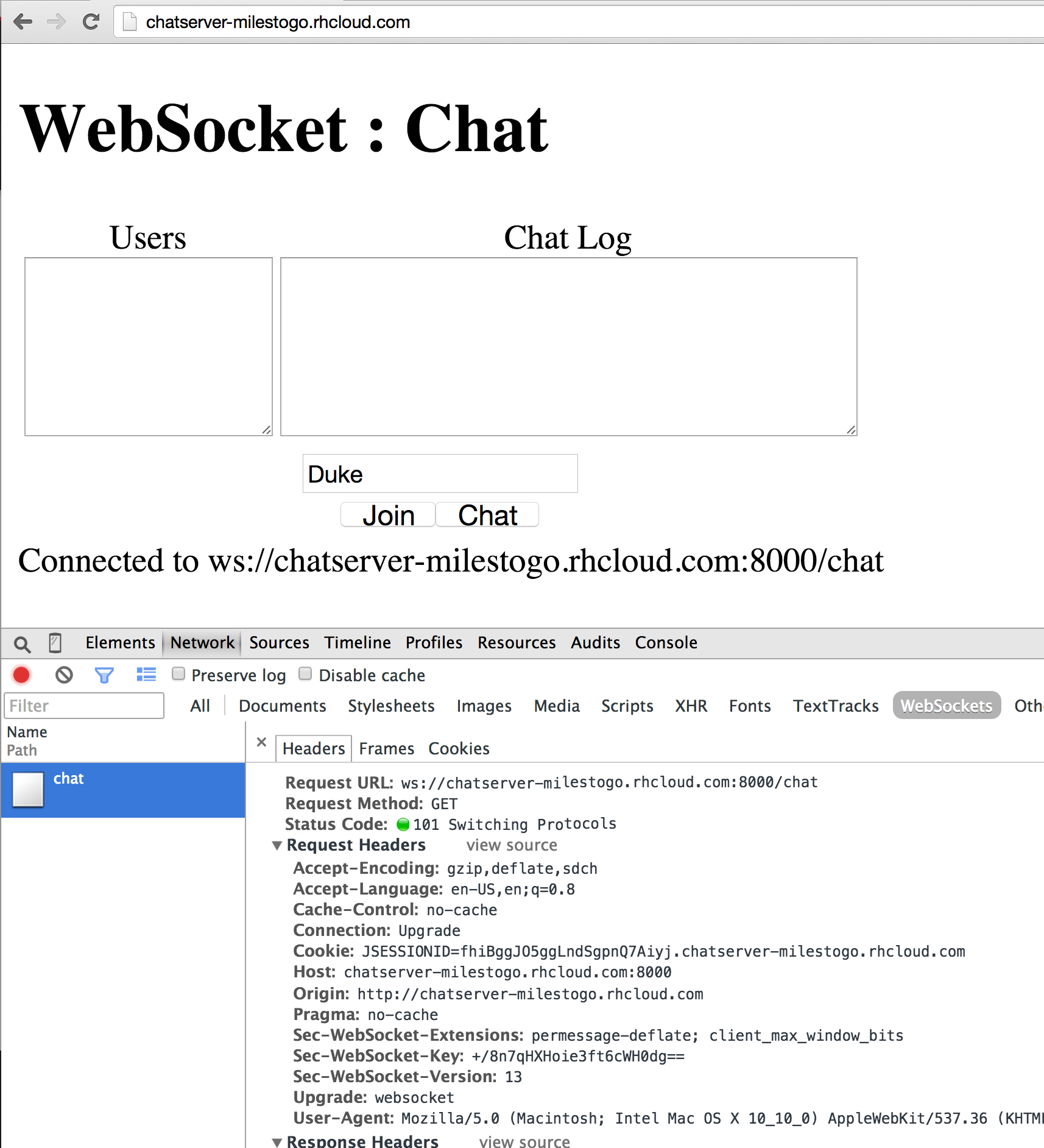Chat is one of the most canonical sample to explain WebSocket. Its a fairly commonly used interface and allows to explain the fundamental WebSocket concepts very easily. Of course, Java EE 7 WebSocket has one too, available here! You can easily run it on WildFly using the following steps:
|
1
2
3
4
5
6
7
8
|
curl -O http://download.jboss.org/wildfly/8.1.0.Final/wildfly-8.1.0.Final.zip
unzip wildfly-8.1.0.Final.zip
./wildfly-8.1.0.Final/bin/standalone.sh
git clone https://github.com/javaee-samples/javaee7-samples.git
cd javaee7-samples
mvn -f websocket/chat/pom.xml wildfly:deploy
|
And then access it at http://localhost:8080/chat/.
One of the biggest advantage of WebSocket is how it opens up a socket over the same port as HTTP, 8080 in this case. If you want to deploy this application to OpenShift, then WebSocket is available on port 8000 for regular access, and 8443 for secure access. This is explained in the figure below:
If you want to run this Chat application on OpenShift, then use the following steps:
- Click here to provision a WildFly instance in OpenShift. Change the name to “chatserver” and everything else as default. Click on “Create Application” to create the application.
- Clone the workspace:
123 - Edit the first line of “javaee7-samples/websocket/chat/src/main/webapp/websocket.js”from:
123var wsUri = "ws://" + document.location.hostname + ":" + document.location.port + document.location.pathname + "chat";
to
123var wsUri = "ws://" + document.location.hostname + ":8000" + document.location.pathname + "chat"; - Create the WAR file:
1234cd javaee7-samplesmvn -f websocket/chat/pom.xml - Copy the generated WAR file to the workspace cloned earlier:
1234cd ..cp javaee7-samples/websocket/chat/target/chat.war chatserver/deployments/ROOT.war - Remove existing files and add the WAR file to git repository:
1234567cd chatservergit rm -rf src pom.xmlgit add deployments/ROOT.wargit commit . -m"updating files"git push
And this shows the output as:
1234567891011121314151617181920212223242526Counting objects: 6, done.Delta compression using up to 8 threads.Compressing objects: 100% (4/4), done.Writing objects: 100% (4/4), 6.88 KiB | 0 bytes/s, done.Total 4 (delta 1), reused 0 (delta 0)remote: Stopping wildfly cartremote: Sending SIGTERM to wildfly:285130 ...remote: Building git ref 'master', commit 05a7978remote: Preparing build for deploymentremote: Deployment id is 14bcec20remote: Activating deploymentremote: Deploying WildFlyremote: Starting wildfly cartremote: Found 127.2.87.1:8080 listening portremote: Found 127.2.87.1:9990 listening portremote: /var/lib/openshift/544f08a850044670df00009e/wildfly/standalone/deployments /var/lib/openshift/544f08a850044670df00009e/wildflyremote: /var/lib/openshift/544f08a850044670df00009e/wildflyremote: CLIENT_MESSAGE: Artifacts deployed: ./ROOT.warremote: -------------------------remote: Git Post-Receive Result: successremote: Activation status: successremote: Deployment completed with status: success454bba9..05a7978 master -> master
And now your chat server is available at: http://chatserver-milestogo.rhcloud.com and looks like:
Enjoy!






I tried a few months ago exactly the same. It didn’t work and i see now why. I need to use the port 8000 for the websocket connection.
Thanks
Rudy